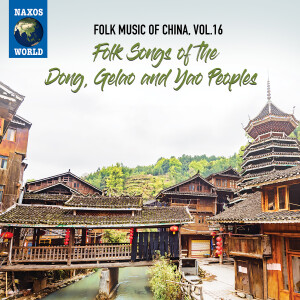 At the risk of sounding like a broken record, this installment of Naxos World’s ambitious series on the folk songs of China is stunning. Anyone who likes multipart ensemble singing with intricate, close harmonies will find this disc absolutely indispensable. I’m a big fan of the choral music of Eastern Europe and the Balkans, and the music of the Dong and Yao people on this disc rivals anything found there.
At the risk of sounding like a broken record, this installment of Naxos World’s ambitious series on the folk songs of China is stunning. Anyone who likes multipart ensemble singing with intricate, close harmonies will find this disc absolutely indispensable. I’m a big fan of the choral music of Eastern Europe and the Balkans, and the music of the Dong and Yao people on this disc rivals anything found there.
This album, the 16th in a series of 20 exploring China’s rich and diverse musical heritage, features the grand songs of the Dong, love songs of the Gelao, and two-voice songs of the Yao peoples. All three of these groups live in southern China: The Dong in Guizhou, Guangxi and Hubei provinces, the Gelao mostly in western Guizhou, and the Yao in Hunan, Guangdong, Guangxi, Guizhou, and Yunnan. The Yao’s largest branch is also known as the Mien, and many also live in Laos and the United States.
This volume has the most individual tracks of any I’ve reviewed. Of the 37 tracks fully 15 are from the Dong, 13 from Gelao and nine from the Yao – although those nine tracks include only two songs, their multiple verses separated into distinct tracks.
The disc opens with something that might sound familiar to residents of the northeastern U.S., “The Song of Cicadas in May.” It is a quite stunning way to open an album, with a group of high female voices leading the verse, joined a few moments later by a male chorus, all in multiple layers of harmony, often in very long droning notes. And during some of those drones, a group of the female voices begins a vocal modulation somewhere between a yodel and a ululation, giving a distinct impression of a concatenation of cicadas or locusts singing. It’s unlike anything I’ve ever heard, except for another song a few tracks later, “Song of Cicadas in March.”
The extensive Dong selections include songs by male chorus, children’s choruses, female duets and more. Nearly all feature hair-raising close harmonies and some are accompanied by the plucked pipa or a bowed lute. According to the liner notes, “Grand songs are unaccompanied multi-part choruses sung by either all men, all women or all children, to ensure an equal tone. These songs have a history going back more than two thousand years. The heterophonic grand songs usually employ drones, which play the tonic or mediant note.”
The Yao selections are just as arresting in their own way. They’re a bit quieter and lower-key, all duets sung in close harmonies that seem to create a third note between the two actually sung by the musicians. There are just two songs, one with five verses, the other with four. I could listen to this kind of music by the hour and wish more selections were included on this set. According to the liner notes, “The Yao folk songs on this album come from Libo County in Guizhou, where three branches of the Yao people live. They are all two-voice songs. The harmonic intervals between the two voices are usually a major third, a minor third or a perfect fourth.”
It’s a little unfair to the Gelao musicians to sandwich their selections between the Dong and Yao with their intricate harmonies. But there’s a lot to enjoy in these 13 tracks as well. “Red Plum Blossom” is billed as a work song, declaimed in a call-and-response style with one calling out a few words, answered by a small mixed chorus. The male voice singing “San Yao Tai (Song of Offering Tea)” puts on an impressive and impassioned performance. A children’s chorus is beguiling in its performance of the song with the best title on this disc, “Chinese Hwamei Tweeting Happily on the Mountain.” And “A Cowboy Song” starts off with the cowboy singing his jaunty verses by himself, but by the time it wraps up with a big loping chorus, I for one can picture the equivalent of Roy Rogers riding happily into the sunset.
Hats off to the performers listed on this CD, including children from Zaidang Village, villagers from Dimen Village, Jiulong Village, Xiaohuang Village, and Yandong Village.
I had no idea that any of the folk music of China or Southeast Asia included this kind of harmonically rich duo and ensemble singing. I shouldn’t have been surprised. Any nation as large as China with such a wide variety of cultures, each with its own long history and artistic traditions is bound to create all manner of music. As with the other volumes, this one comes with a 16-page booklet with lots of helpful information about the people and the music. Vol. 16 of the Folk Music of China series is yet another reminder of the vitality of the folk traditions found throughout China and East Asia. Learn more and listen to samples on the Naxos website.
(Naxos World, 2021)
